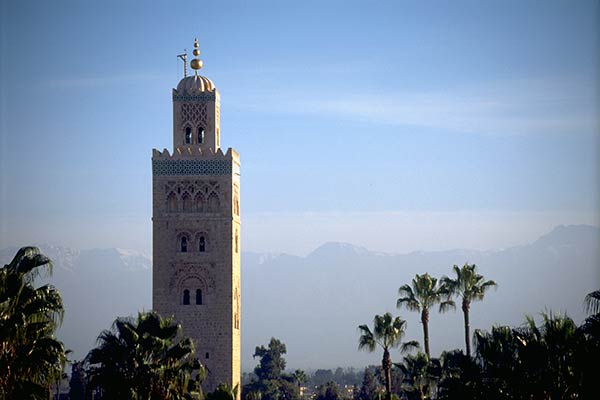
Minaret of the Koutoubia Mosque, Marrakesh, Morocco (Enlarge)
Sacred sites of Morocco and Islamic pilgrimage from Northwest Africa
Islam was brought to North Africa by early Arab warriors conquering territories (Oqba Ben Nafi in 680 and Moussa Ben Nosair in 703 - 711) and by traders voyaging back and forth along ancient trans-Saharan caravan routes. The first African pilgrimages to Mecca were from Cairo during the era of the Fatamid dynasties (909 - 1171). These early Muslims, traveling in camel caravans across the Sinai Peninsula to the Hijaz region of Arabia (where Mecca is located), established a route that was used continuously until the 20th century. By the 13th century, pilgrim routes across North Africa from as far west as Morocco linked with the Cairo caravan to Mecca. Three caravans were regularly started from the Moroccan towns of Fez, Marrakech and Sijilmasa. They often combined on the route and proceeded under a united leadership eastward across the North African deserts. Composed of pilgrims, merchants and guards, the great caravans often had a thousand or more camels. Covering perhaps twenty miles a day and visiting the fabled Islamic mosques of Tlemcen (Algeria) and Kairouan (Tunisia), they took many months to reach Egypt. Beginning in the 19th century, a sea route through the southern Mediterranean to Alexandria became the most favored route for Moroccan pilgrims journeying to Mecca.
Early records show that the Islamic pilgrimage tradition in West Africa dates from the 14th century, when certain rulers from the region, recent converts to Islam, began to put the teachings of Islam into practice. These royal pilgrims traveled in opulent style with hundreds of slaves and warriors, carried gifts for the rulers through whose territories they passed, and for safety often joined the trans-Saharan caravans traveling from Morocco to Egypt. With the increasing Islamisation of the West African territories during the 15th and 16th centuries, the practice of royal pilgrimages declined to be replaced by large numbers of peasant pilgrims. Several pilgrimage routes across the sub-Saharan savannas gradually developed between 1600 and 1800 as Islam was introduced to these regions. The dangers and hardships involved in using both the trans-Saharan and savanna pilgrimage routes were extreme. The risk of death on the pilgrimage route from disease, thirst and violence was considerable, as was the possibility of enslavement. During certain periods the conditions were considered so bad that pilgrims departing for Mecca were not expected to return home. On departure they were obliged to sell their property and to give to their wives the choice of divorce if they were not accompanying them.
The 20th century European occupation of the Sahara and savanna lands brought increased security and transportation improvements that were to revolutionize the Mecca pilgrimage and greatly expand the numbers of pilgrims coming from West Africa. By the early 1900's railways were transporting thousands of affluent pilgrims, while the less affluent simply walked along the tracks. Automobile and bus transport further contributed to the growth in pilgrim numbers. By the mid-20th century the savanna route, because of its less rugged terrain, had mostly replaced the far older Saharan route.
In the 1950's the possibility of travel by air still further increased the numbers of pilgrims making the journey to Mecca, but not at the expense of the land routes. The land pilgrimage routes have continued to be popular. Factors explaining this continuing overland pilgrimage include poverty (air fare is too expensive for most Africans), the desire of pilgrims to visit famous places of Islam in North Africa, and, most of all, the belief that the difficulties incurred on the land routes (as contrasted to the rapid and easy air routes) actually increase the spiritual benefit of the pilgrimage. However, a post-colonial factor inhibiting the free movement of pilgrims across North Africa has been the rise in nationalism and the closing of borders to overland travelers. The source countries do not wish to lose their populations, and those countries along the land routes fear the development of substantial minority groups.
Sacred sites in Morocco
Scattered throughout the deserts, coastlines and mountains of Morocco are sacred sites and pilgrimage places specific to the indigenous Berber culture and the Roman, Jewish and Islamic people who settled in the northwest reaches of the African continent. The first inhabitants of this region, called the Maghreb, were the Berbers, (the word Berber is derived from the Greek word barbaros and anthropologists believe the Berbers may have a remote European-Asiatic origin). A Carthaginian trading presence was well established along the Mediterranean coast by the 3rd century BC. The Romans, who built their great city of Volubilis in the interior, followed this in the 1st century AD. The most notable, and lasting, immigrants, however, were the Islamic Arabs who began to enter the Maghreb between 703 and 711.
In 788 (or 787) AD, an event occurred that was to forever change the trajectory of Moroccan culture. Idris ibn Abdallah (or Moulay Idris I as he is called in Morocco), the great-grandson of the Prophet Muhammad fled west from Baghdad and settled in Morocco. The heir to the Umayyad Caliphate in Damascus, Moulay had participated in a revolt against the Abbasid dynasty (which had usurped the leadership of the Umayyad dynasty and precipitated the split between the Shia and Sunni sects). Forced to flee Abbasid assassins, Moulay initially found asylum in Tangier but soon thereafter tried to establish himself among the remnants of the old Roman city of Volubilis. Before long he moved to the nearby region of Zerhoun, where he founded the town that is now called either Moulay Idris or Zerhoun (and which is the most venerated pilgrimage site in all of Morocco). The local Berber tribes, passionate neophytes of Islam, were convinced of Moulay's power to lead as both king and iman (spiritual guide) and his exemplary conduct soon ensured his lordship over many of the Berber tribes.
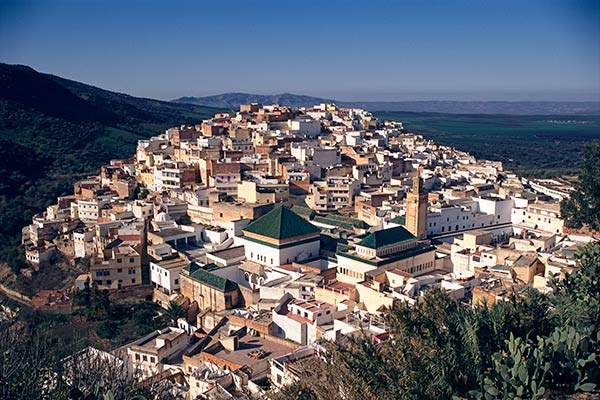
The Holy City of Zerhoun, Morocco (Enlarge)
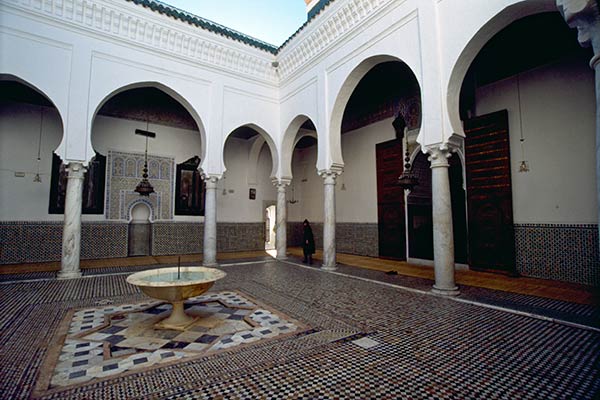
Courtyard of the Zawiya of Moulay Idris I, Zerhoun, Morocco (Enlarge)
The growing power of Moulay Idris I troubled the Abbasid Caliph, who sent an assassin to poison him in 791. The death of Idris, and the resulting destabilization of the fledgling Moroccan Umayyad state, delighted the Caliph in Baghdad. Before long, however, the picture changed. One of the concubines of Idris I gave birth to a son two months after his father's death. This child grew to be an extraordinary being. Writing of Idris II, the historian Rom Landau, says: "In the lore of the Moroccans, Idris II was a being of almost magical attributes. An exceptional young man he certainly must have been. At many points we are reminded of one of the greatest sages of Islam, Ibn Sina or Avicenna. At the age of four little Idris apparently could read, at five write, at eight he knew the Koran by heart, and by then is said to have mastered the wisdom of all the outstanding savants. He was of real physical strength as well, and when he became officially sovereign in 805 at the age of thirteen, he had already accomplished feats of endurance that men twice his age could not emulate. His profound Islamic faith enhanced all these advantages and increased the veneration accorded him."
In the year 809, Idris II refounded the city of Fez on the left bank of the river Fez (twenty years earlier his father had founded a city on the right bank). During the next nineteen years, until he died in 828 at the age of 35, Idris II began to unify Morocco, to establish its firm allegiance to Islam, and to prepare the way for the Arabization of an amorphous and mainly tribal society. Doing so, he brought together in one faith and under one banner the kernel of a future state. For the next twelve hundred years the monarchic tradition established by Idris I & II maintained its hold on Morocco, and the country's cultural progress became intimately linked to each dynasty in succession. The noble beauty of its great mosques - among the finest examples of Islamic architecture - are due to the patronage of sultans from the Almohad, Marinid and Sa'dian dynasties.
Throughout the centuries the mausoleums (burial sites) of Moulay Idris I in Zerhoun and Moulay Idris II in Fez have become the primary pilgrimage sites in Morocco. (Originally it was thought that Idris II was buried, like his father, in Zerhoun, but the discovery in 1308 of an uncorrupted body in Fez, gave impetus to the establishment of a cult of Moulay Idris II. Local women who come to light candles and incense, and pray for ease in childbirth venerate the cult's shrine. The Sultan Moulay Ismail rebuilt the shrine itself in the 17th century.)
The existence of pilgrimage places, other than the holy shrine of the Ka'ba in Mecca, is a controversial subject in Islam. Orthodox Muslims, following the dictates of Muhammad's revelations in the Koran, will state that there can be no other pilgrimage site than Mecca. Likewise, Orthodoxy maintains that the belief in saints is not Koranic. The reality, however, is that saints and pilgrimage places are extremely popular throughout the Islamic world, particularly in Morocco, Tunisia, Iraq and Shi'ite Iran. Edward Westermarck, a noted scholar of Moroccan culture (Ritual and Belief in Morocco) writes that,
"The cult of saints grew up on the soil of earlier paganism; and its growth was actually furthered by the stern monotheism of Islam, which made intercessors necessary for filling up the gap which separated men from their god. When it spread to Africa it found fresh support in the native ideas of the Berbers; and their belief in soothsaying or holy women has certainly had something to do with the large numbers of female saints among their Islamisised descendants...... A place which is in some way connected with a saint partakes of his baraka and they are marked in different ways and under different names. A noted saint often has a qo'bba or qu'bba erected over his grave. This is usually a square, whitewashed building with a horse-shoe door and an octagonal dome. The qo'bba developed out of the tent which the Arabs of olden times used to pitch over the body of a departed person of importance. The holiest part of a sanctuary in which a saint is buried is the grave itself. The grave of an important saint is often marked with a cenotaph, called darbuz, this being a large chest covered with a colored cloth upon which are embroidered passages from the Koran. The sanctity of a saint is communicated not only to the building in which he is buried and the objects contained in it, but to everything inside his horm or harm, that is, the sacred domain of the saint. The horm may be restricted to the building over his grave, but it may also extend far beyond it. The limits of a saintly horm are often indicated by stone cairns outside the shrine. Very frequently a cairn of stones made at a place where a holy person has rested or camped is whitewashed and has a stick with a white flag stuck into it, and the same is the case with many walled enclosures and rings of stones. White is a clean and auspicious color, which keeps away defilement and evil influences. The town or village around the shrine of some great saint is called his za'wia. Fez is the za'wia of Mulay Idris the younger, Zerhoun is the za'wia of Mulay Idris the elder."

Zawiya of Sidi Ali Bousseerrghine, Sefrou (Enlarge)
A typically Moroccan phenomenon is maraboutism. A marabout is either a saint or his tomb. The saint may be a figure of historical importance in Moroccan culture (such as Moulay Idris I) or a Sufi mystic of sufficient piety or presence to attract a following. In the case of a Sufi saint, his followers often confine themselves to the monastic enclave and retreat (za'wia) into which the saint's dwelling had been transformed, devoting themselves to prayers and charitable works. After the saint's death, his tomb would continue to be visited by followers thus developing into a place of pilgrimage. Dozens of saints from ages past are still revered by Moroccans, and their musims, or feast days are the occasion for the assembling of large crowds at the za'wiya of the saint. Besides their religious functions, Musims feature horse races, folk dancing, song recitals and colorful markets filled with native crafts. The two most important musims are those of Moulay Idris the elder in Zerhoun on August 17 and Moulay Idris the younger in Fez in mid-September.
Besides the mausoleums of Moroccan saints, certain mosques also attract large numbers of pilgrims. Primary among these are the Kairouine mosque of Fez and the Kutubiya (Koutoubia) mosque of Marrakech.

Kairouine Mosque (foreground) and Zawiya of
Moulay Idris II (background), Fez, Morocco (Enlarge)
Deep in the center of the oldest part of Fez, the great Kairouine (Qarawiyin) mosque is entirely surrounded by narrow alleyways, clusters of markets and barrack-like houses. Founded in 859 by Fatima, a wealthy woman refugee from the city of Kairouan in Tunisia, the mosque underwent several renovations and additions, most notably those of 956 (when the present minaret was erected), 1135 and 1289. The inside of the mosque is simple and austere, consisting of sixteen white-painted naves separated from one another by rows of horseshoe arches born on plain columns; it accommodates 22,700 worshippers who may enter through seventeen separate gates. Adjacent to the mosque is a spacious courtyard whose floor is intricately tiled with hundreds of thousands of precisely cut black and white stones. In the center of the courtyard is a bubbling fountain and at each end there stands an open-air pavilion supported on slender marble columns. The historian Rom Landau writes that, "these columns are covered with intricate carving, and they support arches whose similarly carved surfaces suggest the incisions of a silversmith rather than the work of a stone-carver. Indeed these arches might well be described as pieces of jewelry rather than of architecture. With its back-wall pierced by open-arched doorways, the green tiles on the roof, and its profusion of colored tiles, the entire yard has an almost operatic light-heartedness." In addition to its unique architecture the Kairouine mosque has the honor of being one of the oldest universities in the world. Among its students were the great Jewish philosopher Maimonides, the brilliant Ibn al-Arabi, and the 10th century Christian Pope, Silvester II, who encountered the Arabic numerals and decimal system that he later introduced to Europe.

Courtyard and minaret of Zawiya of Moulay Idriss II, Fez, Morocco (Enlarge)
With the fall of the Idrisid dynasty and the rise of the Almoravids (1068 - 1145 AD), the seat of Moroccan government moved from the city of Fez south to Marrakesh. The great mosque of Marrakech is called the Kutubiya and it derives its name from the kutubiyin, or booksellers, that originally clustered about the base of the mosque. Begun around 1150, shortly after the conquest of the city by the Almohad dynasty (1145 - 1250 AD), it was completed by Sultan Yacoub Mansour in 1199. The pride of the Kutubiya is its minaret; soaring to a height of 77 meters, it is one of the most impressive in the entire Islamic world. Persian, Turkish and Egyptian minarets are usually cylindrical or octagonal; that of the Kutubiya is square, possibly inspired by the Umayyad minaret in Kairouan, Tunisia. Whereas the minarets of Islam's eastern regions are mostly white, brick-built or covered with tiles, the Kutubiya minaret is made of huge blocks of ochre-red local stone that subtly change their hue with the changing angle of the sun's rays. The great mosque, one of the largest in all of Africa, comfortably accommodates more than 25,000 worshippers.
Marrakech has also long been famous for the numerous saints buried in its cemeteries and to whom the dwellers of the city and those from the surrounding countryside have always shown great devotion. In the 17th century, the sultan Moulay Ismail, in an attempt to offset the influence of the pilgrimage known as "The Seven Saints of the Regraga" (undertaken yearly by the tribes in the Chiadma territory), decided that Marrakech should have its own important pilgrimage. The man he put in charge of this project was Sheikh el Hassan el Youssi whose task it was to choose from among the many popular saints of Marrakesh who had lived between the 12th and 16th centuries. Basing his selection on the renown of certain saints, and mindful of the mystical importance of the number seven, he organized the first "Ziara des Sebatou Rijal", the Pilgrimage of the Seven Saints of Marrakech. These seven shrines continue to be visited today.
Other sacred sites, power places and pilgrimage shrines in Morocco
- Zawia (also spelled Zaouia) of Sidi Rahhal, east of Marrakech
- Zawia of Mulay Bus'aib, Azemmur
- Zawia of the Wazaan shereefs, Wazaan
- Zawia of Mulay Buselham, on coast, south of Laraiche
- Kaf l-ihudi cave on Mt. Jbel Binna, near Sefrou
- Jbel l-Hdar holy mountain
- Holy hill outside town of Demnat
- Hilltop shrine of Lalla Tamjlujt, Atlas mountains, sacred to tribe of Unzutt
- Holy hill above village of z-Zemmij, Andjra
- Shrine of Boujad
- Zawia of Mulay Abd as-Salim ibn Mashish, Mt. al-Alam, Rif mountains, near Chefchaouen
- Zawia of Sidi Harazin, near Fez
- Zawia of Sidi Kacen, near Tanjier
- Zawia of Sidi Ahhmed Tijane, Fez
- Zawia of Sidi Ali Bousserghine, Sefrou
- Shines of Seven saints of Marrakesh (Sidi Bel Abbes, Sidi Mohammed ben Slimane, etc)
Readers interested in exploring Berber and Islamic holy places in more detail should consult Ritual and Belief in Morocco (volume 1) by Edward Westermarck.
Also consult:
Non-Hajj Pilgrimage in Islam: A Neglected Dimension of Religious Circulation; Bhardwaj, Surinder M.; Journal of Cultural Geography, vol. 17:2, Spring/Summer 1998
Sufism: Its Saints and Shrines: An Introduction to the Study of Sufism with Special Reference to India; Subhan, John A.; Samuel Weiser Publisher; New York; 1970
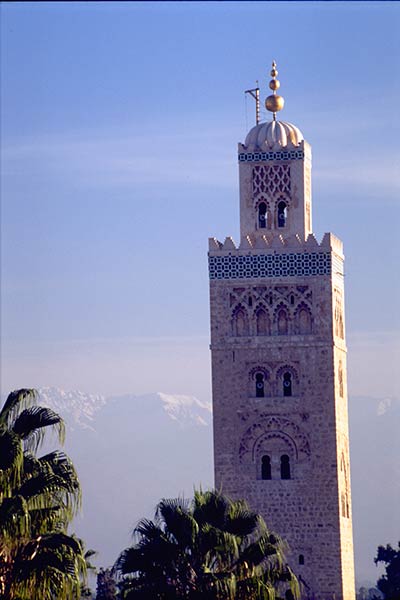
Minaret of Koutoubia Mosque, Marrakesh (Enlarge)
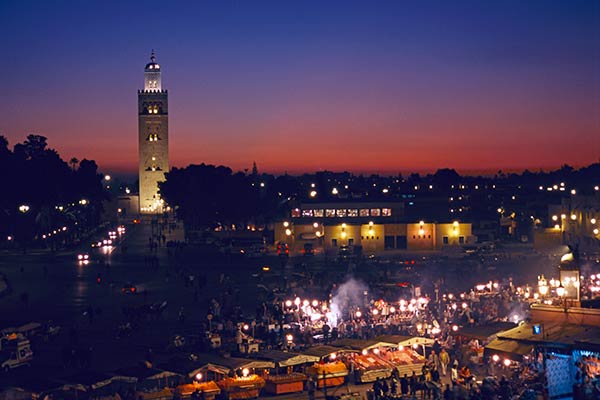
Koutoubia Mosque, Marrakesh (Enlarge)
 Martin Gray is a cultural anthropologist, writer and photographer specializing in the study of pilgrimage traditions and sacred sites around the world. During a 40 year period he has visited more than 2000 pilgrimage places in 165 countries. The World Pilgrimage Guide at sacredsites.com is the most comprehensive source of information on this subject.
Martin Gray is a cultural anthropologist, writer and photographer specializing in the study of pilgrimage traditions and sacred sites around the world. During a 40 year period he has visited more than 2000 pilgrimage places in 165 countries. The World Pilgrimage Guide at sacredsites.com is the most comprehensive source of information on this subject.